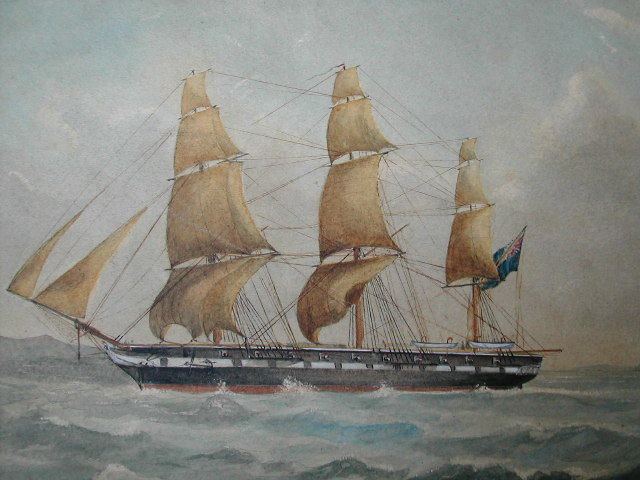Name HMS Grasshopper Laid down August 1812 Tons burthen 382 ⁄94 (bm) Launched 16 February 1813 | Ordered 6 January 1812 Fate Sold on 30 May 1832 Construction started August 1812 Builder HMNB Portsmouth | |
 | ||
Class and type Cruizer-class brig-sloop (ship-sloop from 1822) | ||
HMS Grasshopper was a Royal Navy 18-gun Cruizer-class brig-sloop launched in 1813. She was the second ship of the class to bear the name; the first Grasshopper had been stranded at Texel and surrendered to the Batavian Republic on Christmas Day 1811. The present Grasshopper remained in service until sold in 1832.
Contents
Service
On 6 October 1813, Grasshopper recaptured the Dryades, Humphries, Master. Dryades had been sailing from Dublin to London when she was captured. After Grasshopper recaptured Dryades, Dryades arrived at Portsmouth on 7 October.
From 1814 Grasshopper served in the Mediterranean. On 29 April and 18 May 1815, she captured the Maruccia, Madonna del Montalleggro, and the Immaculata Concezione. Another report expands on this, crediting Grasshopper with detaining the Concession, sailing from Gallipoli, Apulia to Marseilles, the Madame de Monte Allegro, from Naples, the Majorca, from Naples, the Concizione, from Capo Danza and Messina to Naples, and the Concizime, from Leghorn and Civitavecchia to Naples.
Unfortunately, Grasshoper's prize agents, Messers Lark and Woodhead, went bankrupt in 1816. As a result, the last of the prize money from these captures did not arrive until 1850, and then was minor.
More importantly, on 13 May was part of the squadron that was present at the surrender of Naples during the Neapolitan War, though she herself was not actually there. A British squadron, consisting of Grasshopper, the 74-gun Tremendous, the frigate Alcmene, and the sloop Partridge blockaded the port and destroyed all the gunboats there. Parliament voted a grant of £150,000 to the officers and men of the squadron for the property captured at the time, the grant being paid in 1816. Initially, Grasshopper was excluded from the payment as she was not actually present, having been sent on an errand. However, Sir Charles Barrard sued and eventually the court agreed that there had been a blockade and that Grasshopper had been part of the blockade and so was entitled to share in the grant. The money was paid in May 1819, with the other officers and crew of the other three vessels being required to repay part of their grant.
Grasshopper then spent 1816 and 1817 in Portsmouth. From 1818 she was assigned to the North America Station, being based at Halifax and Newfoundland. From May 1819 her captain was Commander David Buchan, and in her he carried out an assignment from the Governor, Sir Charles Hamilton, to return the native woman Demasduwit to her people, the Beothuks. Although she died of tuberculosis before the mission could be accomplished, he transported her body to a Beothuk camp by ascending the Exploits River in January 1820. Seeing signs of the Beothuk, but meeting none, they left her body and possessions in a tent by Red Indian Lake and returned to Grasshopper by the end of February.
Between January and June 1822 Grasshopper was in Portsmouth where the Navy converted her to a ship-sloop. In December 1823 Commander John Alpin took command for the Halifax station. On 23 December 1826 Commander Courtenay Edward William Boyle assumed command; at the time Grasshopper was still at Halifax.
Between June 1827 and February 1828 Grasshopper was at Woolwich undergoing repairs and fitting for sea. Commander Abraham Crawford commissioned her on 8 December 1827 for Jamaica.
From 1828 to 1830 Grasshopper served on the West Indies Station, based in Jamaica. There she was involved in suppressing the slave trade.
On 27 June 1828 she captured the Xerxes. Admiral Fleeming had ordered Crawford to patrol Cuba's northwest coast and it was there that Grasshoper encountered the Xerxes. The Xerxes was armed with one 18-pounder gun, four smaller guns, and her 44-man crew was well supplied with small arms. She had sailed with 426 slaves, of whom 406 were still alive. Grasshopper chased Xerxes for 26 hours before capturing her in the Gulf of Mexico; Grasshopper then took her into Havana where British and Spanish Mixed Court condemned (confiscated) the vessel and nominally freed the now 401 surviving slaves on 12 July.
On 22 November Grasshopper captured the Firme, which was carrying 487 slaves when Grasshopper. captured her, having started out from the Gold Coast with 492. Firme had a crew of 43 men, four passengers, and was armed with six guns, four 18-pounders, one 12-pounder, and one 24-pounder. She too went into Havana and was condemned on 18 December. Crawford received promotion to post-captain in the hospital ship Magnificent, which was at Port Royal, Jamaica, on 5 January 1829; he invalided back to Britain on 3 April in the yacht Herald later that year.
Commander Charles Deane assumed command of Grasshopper on 5 January 1829. Commander John Elphinstone Erskine replaced him on 3 May 1830.
Fate
The Navy paid off Grasshopper on 6 September 1831. The Admiralty offered Grasshopper for sale at Portsmouth on 30 May 1832. She was sold on that day to Thomas Ward for £910.
